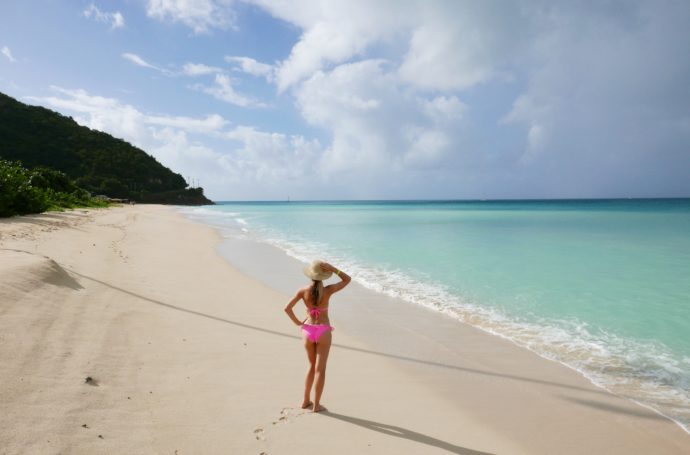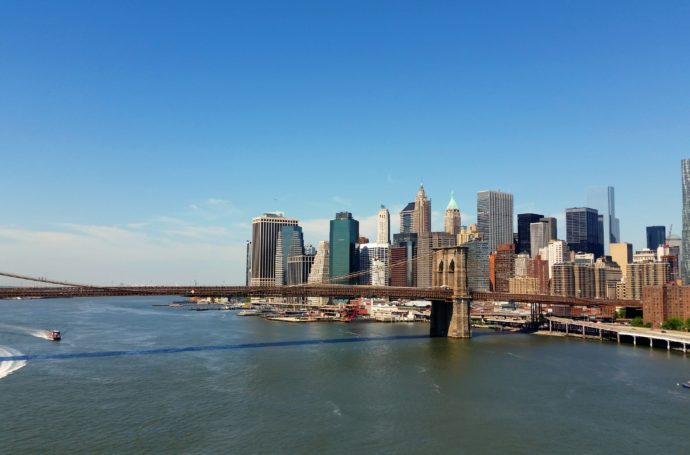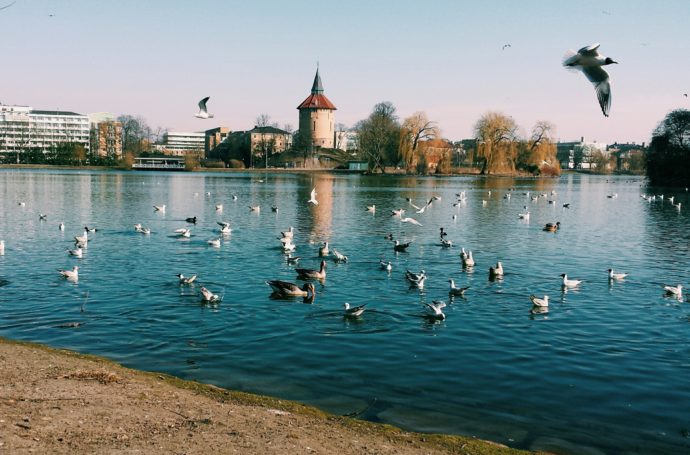Karibe sem prvič obiskala leta 2002. Bilo je za božič, bilo je za mojo prvo plačo (no, vsaj prvi obrok sem pokrila z njo), bila je Dominikanska republika in bila je ljubezen na prvi pogled. Raj za vse, ki želijo okusiti eksotiko prelepih peščenih plaž in turkiznega karibskega morja na najbolj udoben in ugoden možen način. Vendar pa Karibi ponujajo mnogo več kot le “instant turizem”. Za vse, ki ljubite rajske plaže in toplo morje skozi vse leto, a vam raziskovalna popotniška žilica ne pusti, da bi se zgolj svaljkali na ležalniku pod palmo, je na voljo več kot 7.000 manjših in večjih otokov, razpetih med Severno, Srednjo in Južno Ameriko. Med malo manj znanimi, a zato nič manj gracioznimi, je Antigua, ki sva jo obiskala januarja 2017.
Hotel review: Jolly Beach Resort & Spa (Bolans, Antigua)
We chose Jolly Beach Resort & Spa for our first visit to the beautiful Antigua island. We wanted an all-inclusive option for a hassle free vacation, but we knew we would be traveling around a lot, so we didn’t want to pay a fortune for it. Despite very mixed reviews on Tripadvisor, Jolly Beach Resort & Spa with officially 3 stars turned out to be a very good compromise for what we needed.
Location
The resort lies on Jolly Beach, which is indeed one of the most beautiful beaches of Antigua. The transport from the Airport takes around 20 minutes by car (let me point out that the roads in Antigua are a big headache, especially during the night when you don’t see all those huge holes and canals). I’d say the location is more than convenient if you want to visit St Johns and go around the island.
Just before the entrance of the resort there is a Jolly Harbour Marina with all the necessities you need for those “just in case” moments: a very big and well stocked supermarket with rather normal prices, a pharmacy, some souvenir shops, internet café, restaurants and, in case you fall in love with Antigua, a real estate agency with rental and buy-sell options.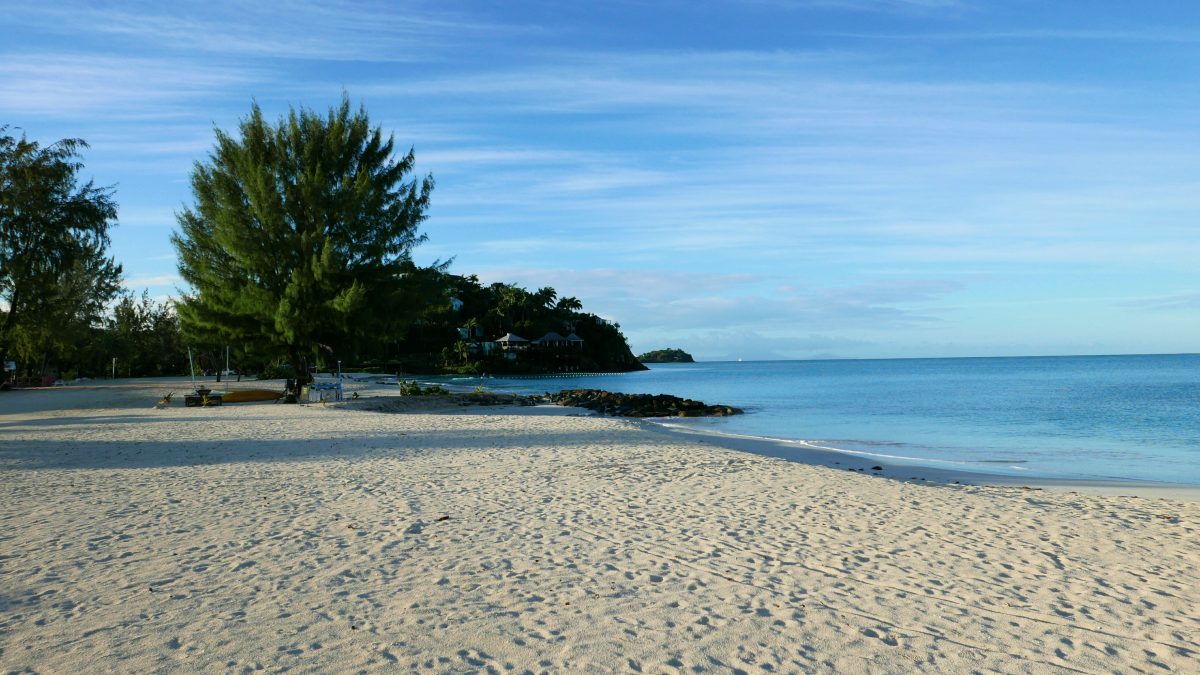
The rooms
I booked Jolly Beach Resort & Spa via booking.com and honestly, I didn’t notice the catch with “supersaver” rooms. I went for the cheapest room with an ocean view and only later found out that these rooms are very small. I wasn’t completely sure about my reservation details and I could have checked whether that was a misunderstanding, but I just didn’t care. We came in very late and all we wanted was a good sleep. The bed was comfy and since we knew we would practically use the room only to change, shower and sleep, we didn’t want to complicate. However, if you want more space and if you come for 14 days, I do recommend you take a normal room.
The bathroom was very tired, so was the other furniture, but again, that didn’t bother me much. After all I didn’t come to Antigua to watch TV and get interior décor ideas. If you are picky, you can choose among 5 other accommodation options – you can check them here. Or you can always go and pick a four or five star hotel 😛
Food
My first impression of the main dining area was quite shocking. Even though I am not a luxury traveler, I am still used to a certain standard when it comes to this issue. The place looks cheap as hell and the choice of food looks even cheaper. But when you get used to the atmosphere and taste the fish choices, you will highly likely loosen up. Breakfast choice is always the same but with still quite a lot of things to choose from – for vegetarians and meat lovers. The story with lunch and dinner is almost the same: soup (different every day and always very delicious!), choice of fish or meat, risotto (different styles and very good) and of course the classics like French fries, burgers and desserts. It may sound boring but it is not, trust me. There is a “chef’s” night once per week, in our case that was Thursday, when they serve food outside and make some special efforts.
What I strongly recommend is to try at least one of the 3 special restaurants for dinner, which you have to reserve one day ahead (every morning for the next day): Seafood, Indian and Italian. We only tried the Seafood one and it was totally worth it. You can chose from the menu and they serve you all the way. Even the wine is much better than in the main restaurant. Just a reminder: for the Italian restaurant you have to pay 20$ and need to wear long trousers, no flip flops and no T-shirts. An unnecessary fuss if you ask me.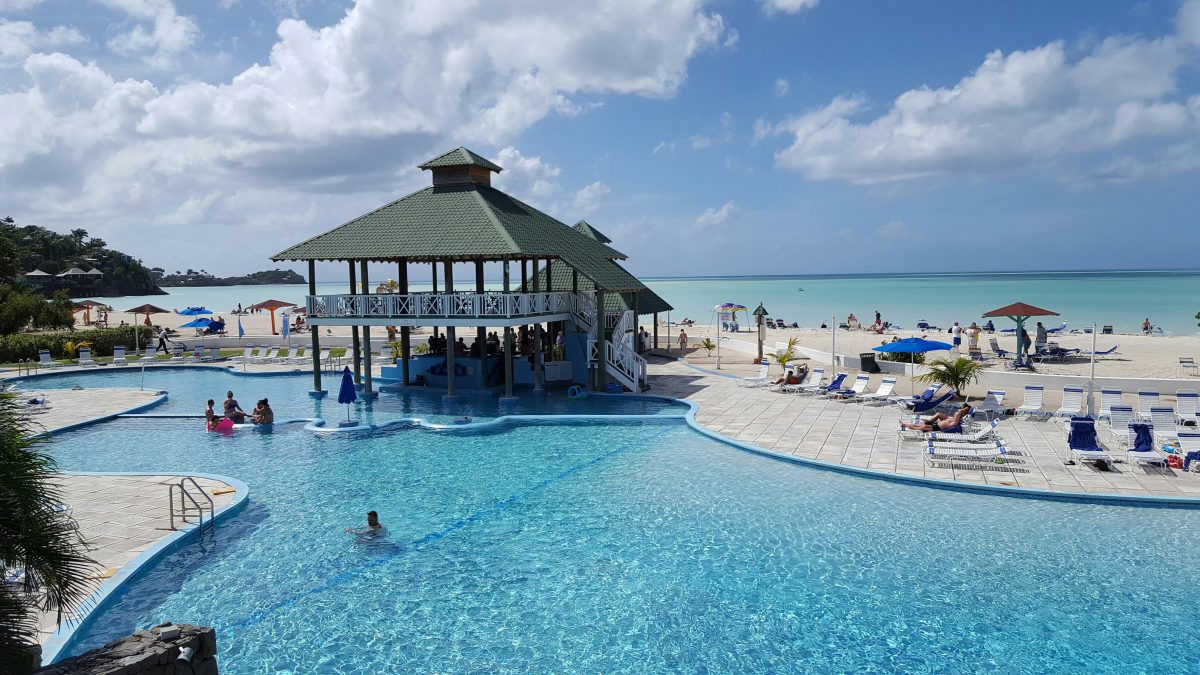
All-inclusive offer
Besides the food in the main restaurants your neon yellow bracelet also allows you to eat at the pool grill (hot dogs, burgers, fries) from noon to 5 pm, so in case you miss your lunch, you are still well taken care of. There are 2 main bars with free local drinks, however getting a drink there seems like a lottery. The waiters are very ignorant and slow, even if you tip them. This is probably a big minus in high season, especially if you are not a person with A LOT of patience. I have read and heard guests complaining about this issue but it just doesn’t seem the hotel management wants to handle it.
There are 2 pools in the resort, one with loud music and day animation like aerobics, dancing lesions, bingo and similar stuff, and another one in more quiet area, both large enough to have a decent swim. It is also well taken care of sports enthusiast – from table tennis and pool tables, to beach volley and a very well equipped fitness studio.
I am not sure why the resort is named Jolly Beach Resort & Spa, because from what I saw, the spa is nothing worth bragging about. From the outside it looked very small, not to mention the killer prices which were a big turnoff for me. I mean who would pay 100$ for a facial in a 3 star hotel, especially after seeing the whole picture. The massages were around 80$, which is almost twice as much as I paid in Maldives last year.
Besides the already mentioned animation at the pool, there are also live music, karaoke and some dance performances every night.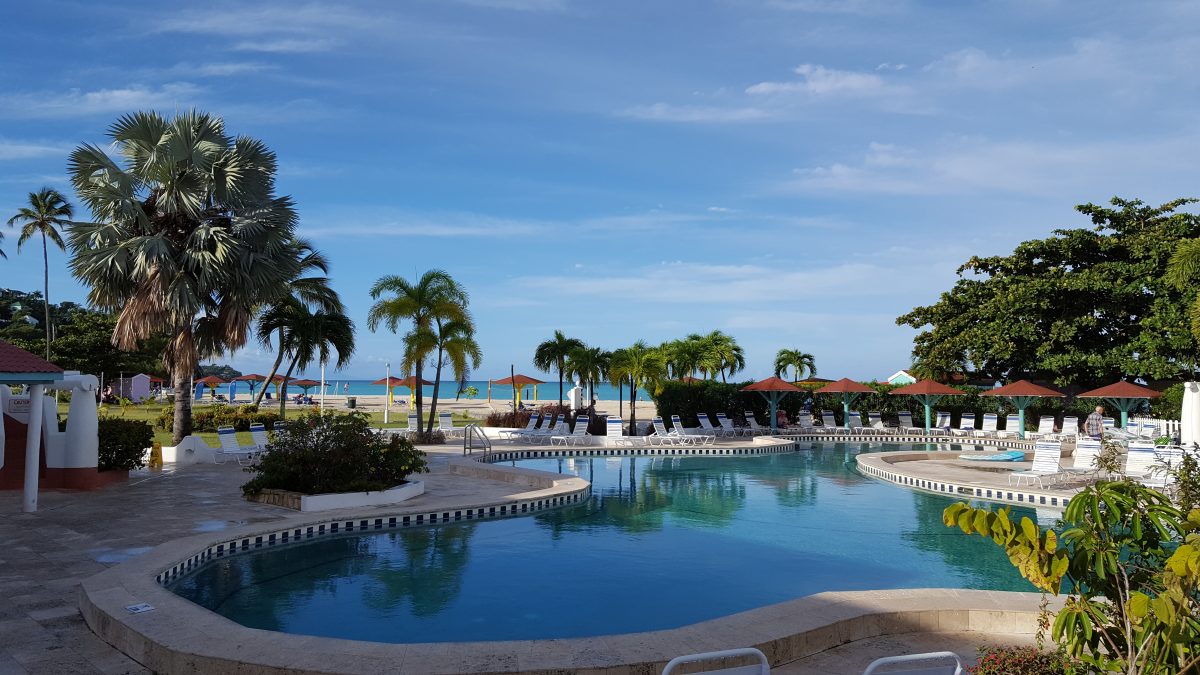
Internet
Another could-be-issue for an internet addict like myself: there is no free Wi-Fi in the rooms. When I checked the hotel, it said “free Wi-Fi” but I it didn’t say where… However, I decided this was a bliss, so I could actually enjoy my vacation. It’s all just a matter of perspective 😉 You can get all the Wi-Fi you want in the lobby, where the signal is great, everything worked well.
Anda’s rate: 7 from 10
Bottom line: It is true what most of the reviews say about Jolly Beach Resort & Spa: you have to go there with an open mind. It is a 3 star hotel and having an all-inclusive option in Antigua is very convenient, considering the high prices in tourist areas. However, if you have experienced something similar for example in Dominican Republic, Jolly Beach resort could be a small shock for you. But if the Nagging Lady Anda enjoyed and survived it without any scratch (meaning no official complaints), it sure can’t be that bad 😉
Slovenes abroad: Rajko, New York (USA)
Rajko moved to USA in September 1995, first to Upton, a small town in Massachusetts, about 30 minutes west of Boston. 6 years later he moved to Miami for a year and a half and then to New York, where he has been living since 2002. He lives on Long Island, about 100 km from New York City.
Hi, Rajko. How’s my favorite city in the world doing these days?
NYC is great. It truly is the best city in the world. The Manhattan vibe is always upbeat and positive, full of energy, everywhere you look. It is very private, in terms of being lost in the crowd of thousands and at the same time you are never alone, no matter what hour of the day.
I will skip the »Why New York?« question – it seems an obvious choice, if you are ambitious and want to go all the way. Am I right?
Well, some people come to NYC because they like the life style and exciting opportunities around every corner; great restaurants of any cuisine you can imagine, museums, Broadway, great night life, especially for young people. Many others, like me, are here for work, that is true. There are endless opportunities in the city if you are good at what you do and willing to work hard and many hours.
Was the decision to move hard to take?
Not at all. Look, I’m from Trzic. Even we, the local people from Trzic, say it is a hole. I traveled quite a lot before, first with our dance group and later for work, thus I saw opportunities beyond the borders. As a matter of fact it was travelling that made me aware of the upcoming collapse of the industry in Slovenia. I took a job that made me travel to Brazil, Taiwan, China, Mexico, Dominican Republic, Puerto Rico, Hungary, Italy, Portugal and Indonesia, all in two years, from 1993 to 1995. That was too much even for me, so asked the company to move me to USA. They agreed so I packed my things and sent them to the new place as if I was never going to return. My moto is whatever you do, do it 100%.
What is the process of integration in the US, I imagine you start with arranging a working visa?
For me it was easy. The company I worked for arranged the working visa and 6 months later I received a Green Card. That is not the case anymore these days, it is much more complicated and lengthy process.
What was the most positive surprise for you, after moving across the Atlantic?
How easy everything was here. People were very warm and friendly. The roads were big and well lit, with great signs, so after the first weekend I already felt like I had been here for a year. What surprised me was that you can negotiate prices on a car, furniture, etc., which I took full advantage off.
And what was the hardest part?
Not having the family and old friends around. Making friends is not easy here. No matter how friendly people are, they have their own longtime friends, they have families and you somehow just don’t fit in. Here in New York people, including myself, are simply too busy to make any kind of deep friendships. Moving around as much as I did, didn’t help the situation.
Is it hard to get a job in New York?
Yes and no. If you are good at what you do, companies will compete for your services, especially in fashion and financial sector. There is of course a big competition with many candidates for every job. Entry level jobs, for a minimum wage, are always available – you can see signs “Help Needed” everywhere. With a settled legal immigration status it is not difficult to get a good job. Americans like foreigners because of our great work ethics.
I know the costs of living in America’s biggest cities are quite high, can you afford to live comfortably with an average US salary?
Yes, the living is very expensive. The average salary in USA is about $43,000 per year. Of course it is adjusted to the cost of living in the area, thus it is much higher in NYC where the entry level office job in a bigger corporation starts at about $35,000 per year after you pay taxes. That doesn’t get you very far in the city – the rent under $1,000 per month practically doesn’t exist.
Many people live outside the city and commute, like I do. We chose to live on Long Island to have a bigger house and some land around it.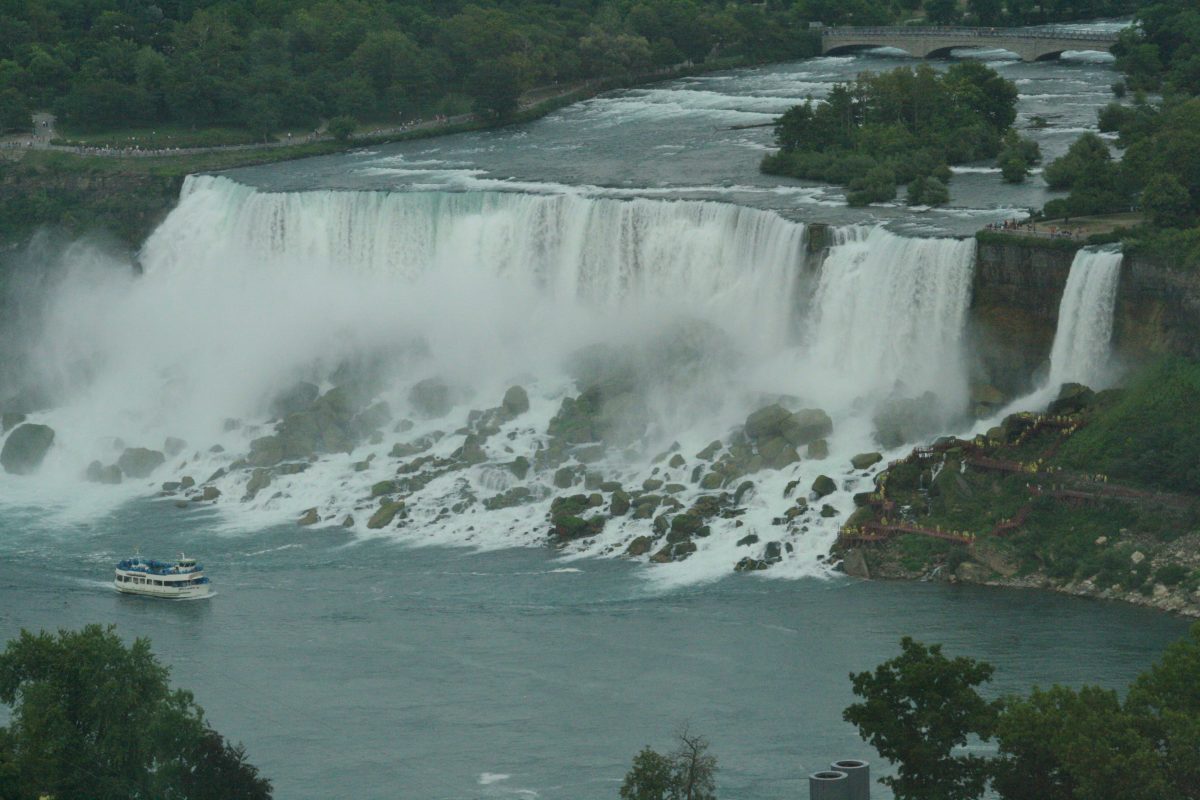
I know the traffic can be a headache in NYC, how do you handle it?
The NYC and suburbs traffic is a nightmare and something that I really dislike. If I went to work by car at the usual hours (7:00 AM and back from 5:00 to 6:00 PM) it took me about 3-4 hours each way. So I rather drive to the local train station, the train ride is about 1 hour and 20 minutes and then I walk. All together it still takes about 1 hour and 50 minutes each way. It’s a killer.
It is the same in all major cities. And NYC is not even the worst city to commute.
Healthcare – currently a big issue in Slovenia. Is it really that expensive to get sick in the US?
True, it is crazy expensive. If you work, you most likely have an insurance from your company but you still have to contribute $5,000 – $10,000 extra if you have a family. If you are single, then it is mostly paid in full by the employer. If you have to pay health insurance by yourself, it costs over $20,000 per year for a family and that still doesn’t cover all cost.
Without insurance, your better don’t get seriously sick. Any kind of surgery will cost $10,000 and can go into numbers with more zeros… However, I have to say that the service is great. You don’t have to wait for anything and everything is available.
What about the situation around the Trump Tower, since we Slovenes got our “first lady”? 🙂
All quiet on the western front. Just like every other euphoria, this one didn’t last very long. The majority of Americans still don’t want Trump as their president, the other half still hates Hillary. There is however a very strong resentment to the proposal that Melania will stay in NYC. People don’t want the daily circus and the expenses, which will definitely add to the financial burden for the residents of NYC.
And every American knows our country now, right?
Well, definitely more people know about Slovenia now. Many know it from newspaper articles presenting the beautiful places we have. In general I get many compliments of the beauty of Slovenia. But I don’t think they look at Slovenia any differently than they did before Melania “happened”.
Seriously, what is the general opinion about Melania?
She is not liked. She married a billionaire who has a shady past with women, so she is regarded as a gold digger, which is OK in the Wall Street world, but not for the first lady in the White House. Then there was her speech, which was a plagiarism of the worst degree, and showed really low class. She is not liked at all, especially among educated people.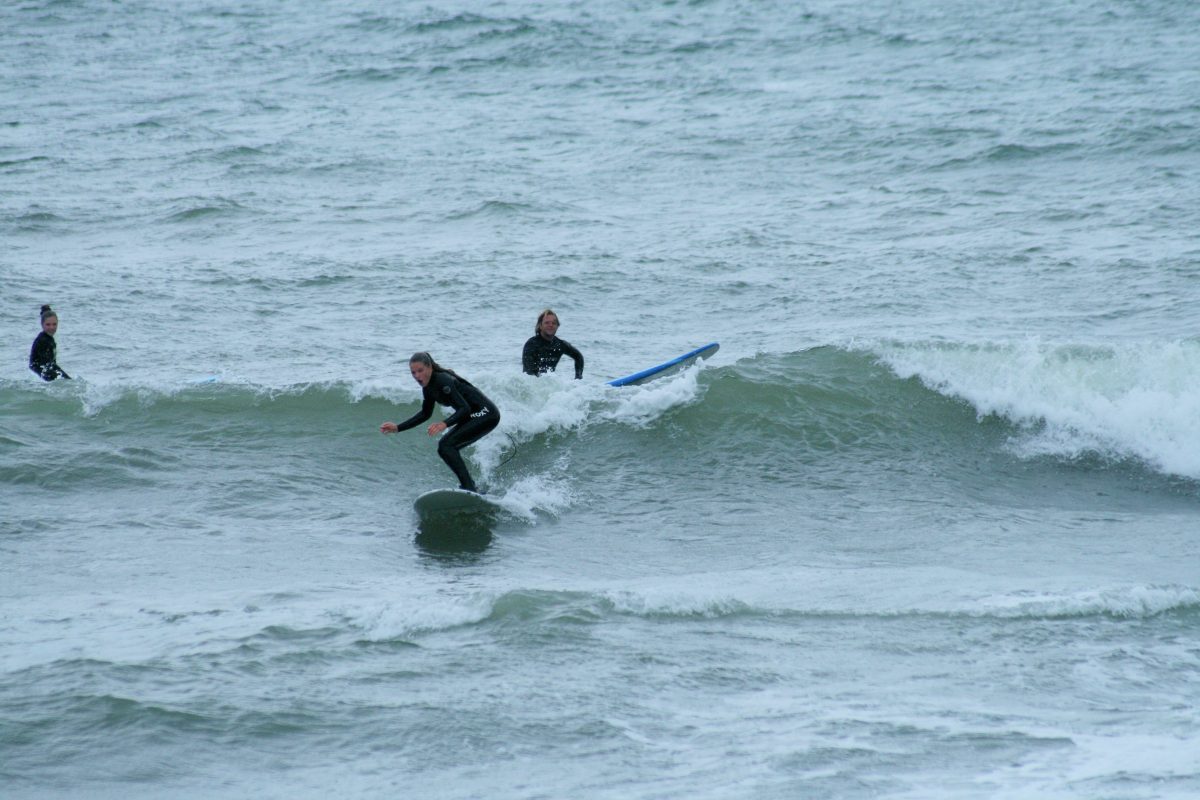
Is there any Slovene community in NYC?
There is. The center is the church of St. Cyril in downtown Manhattan. There is a mass every Sunday and on major Catholic holidays in Slovene. I go there from time to time but not too often. It is far and difficult to manage into kids’ sport schedules, which are practically every weekend.
How often do you travel to Slovenia?
I go home twice a year. Last time it was there in December. Normally I come for a long weekend, Thursday to Monday, but every two years I bring the whole family and we stay for a week or 10 days. It’s too bad we don’t have any direct flights but they’d probably be much more expensive. Recently I discovered that it is a lot cheaper if you buy separate tickets, i.e. NY to Frankfurt and then Frankfurt to Ljubljana, instead of NY to Ljubljana via Frankfurt. It is at the end the same flight but you save some serious money.
What has in your opinion changed in Slovenia, since you moved?
Cities are much better kept. The facades are new and most of the buildings are renovated. There are more highways and you don’t have to show your passport every 30 minutes when you come to the border. On the down side it is the collapse of manufacturing industry. Many factories have closed, lots of business has been lost. However, it still seems that most people are better off. Just like in US, everyone has the latest model of the phone and other gadgets. Cars are everywhere. I’m not sure if my impression is correct but I hope people are better off now.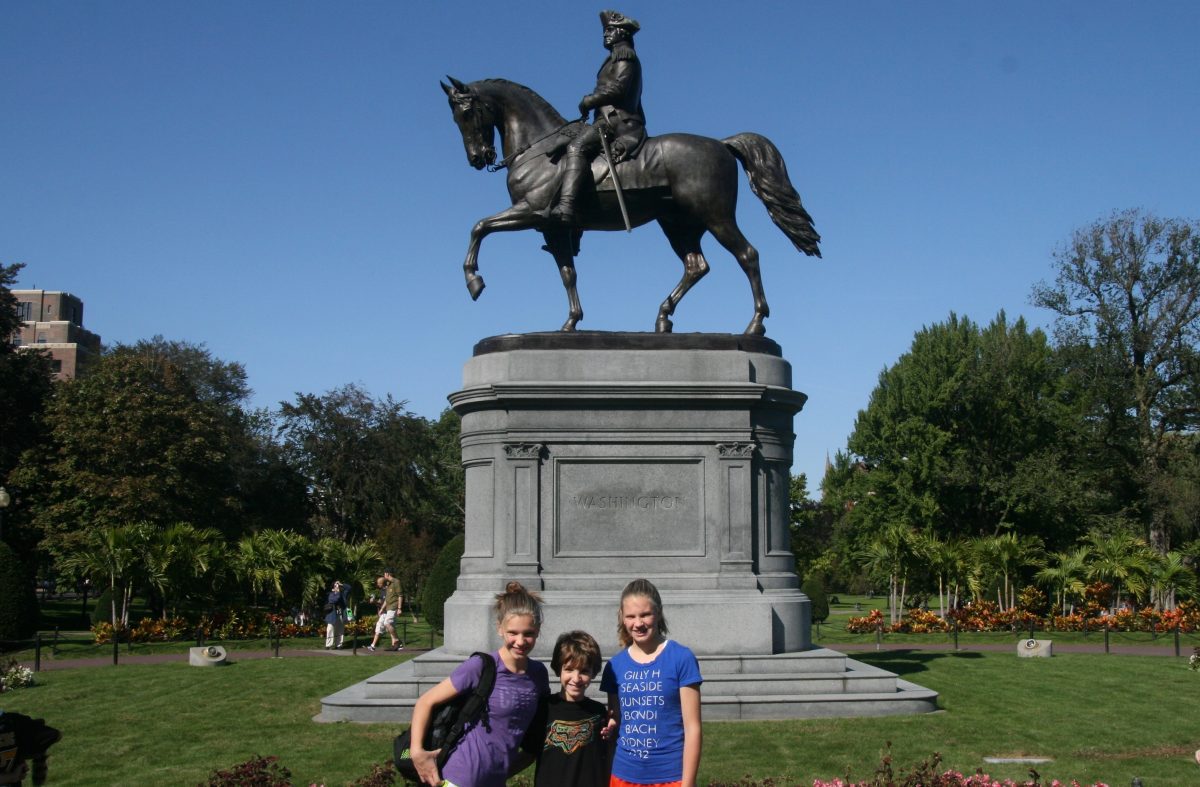
I know what my top choices are, but let me hear it from a local point of view – top 5 things to do or see in NYC?
This is the hardest question to answer, sorry I can’t do only 5:
- Museums: Metropolitan, Natural History, The Intrepid Sea, Air and Space Museum…
- Statue of Liberty
- Central Park
- Top of the Rock at sunset
- Empire State Building
- Macy’s – the biggest store in the world
- Walk over the Brooklyn Bridge
- Food, food, food….
And your top 5 places in the East Coast?
Boston is my favorite city in US. It is small, with a heart of a town and there’s the great North End with great Italian food. Then Miami Beach with some of the greatest beaches in the world, Florida Everglades, Washington DC, a historical place with so much to do and to see and Niagara Falls.
Is there anything you miss about Slovenia?
Mountains, hiking, family and friends. I miss the slower pace and getting together on the fly, without any major planning…
Do you get any visits from your Slovene friends?
I have not had any friends visiting yet. I guess it is too expensive for them to travel to the States. My relatives did come to visit and they loved the shopping. We have some stores where you can buy good quality products inexpensively. 🙂
Are you planning to stay in the US for good?
Yes. I got used to the life style. I have to admit that I got a bit spoiled in the land of plenty.
Let me finish with my US headache: American coffee. Do you get used to it eventually? Where should I go in the NYC if I want a great Italian cappuccino?
One gets used to the “pear soup”, which is what I called American coffee when I came to the USA. You just have to figure out what you like. Any good Italian restaurant will have a good cappuccino but they’re not open for breakfast. Best hotels serve a good one and of course in Little Italy, which is your best bet.

Slovenci v svetu: Rajko, New York (ZDA)
Rajko živi v ZDA že od leta 1995. Najprej ga je pot vodila v Upton, manjše mestece v državi Massachusetts, ki leži 30 minut zahodno od Bostona. Po 6 letih se je preselil v Miami, kjer je živel leto in pol, leta 2002 pa se je ustalil na Long Islandu, približno 100 km iz mesta New York, kjer ima službo. Verjetno ne rabim posebej poudarjati, da mi gre strašansko na živce. V pozitivnem smislu, seveda 🙂
Ejga, Rajko, kako kaj “moj” New York?
New York je fantastičen. Resnično je najboljše mesto na svetu (zavist premaknem še v višjo prestavo, op. a.) Utrip Manhattna je vedno živahen in nabit s pozitivno energijo, kamorkoli se ozreš. Po eni strani se v njem lahko izgubiš v množici, kjer te nihče ne pozna, po drugi strani pa nisi nikoli sam, ne glede na to, ali je dan ali noč.
Preskočila bom klasično vprašanje »Zakaj New York?«, saj se mi zdi, da odgovor že poznam. Gre pač za mesto, kjer enostavno hočeš biti, če si ambiciozen in željan uspeha. Imam prav?
No, nekateri pridejo v NYC zato, ker jim je všeč tak življenjski stil – življenje v metropoli, ki ponuja presežke na vsakem koraku: številne odlične restavracije, nakupovanje, muzeji, Broadway in pa seveda razburljivo nočno življenje, še posebej za mlade. Številni pa s(m)o tu zaradi dela, res je. Mesto ponuja neomejene možnosti za uspeh, če si dober na svojem področju in seveda pripravljen res trdo in veliko delati.
Je bila odločitev o selitvi »čez lužo« težka?
Niti najmanj. Glej, sem iz Tržiča. Še Tržičani mu pravimo luknja. Sicer sem veliko potoval že v mladosti, najprej s plesno skupino, kasneje pa poslovno, tako da sem se dokaj hitro zavedel možnosti, ki jih ponuja tujina. V bistvu so mi ravno potovanja odprla oči, da se slovenski industriji ne piše dobro. Zato sem sprejel ponudbo za službo, v kateri sem v samo 2 letih prepotoval skoraj pol sveta – od Brazilije, Tajvana, Kitajske, Dominikanske Republike, Portorika, Madžarske, Italije, Portugalske, do Indonezije. To je bilo tudi zame enostavno preveč. Zato sem izrazil željo, da se preselim v ZDA, za bolj stalno delo. Delodajalec se je strinjal in ostalo je zgodovina. Spakiral sem praktično čez noč, poslal vse svoje stvari na novi naslov, z namenom, da se nikoli več ne vrnem. Sem namreč mnenja, da če želiš biti v nečem dober, se moraš predati 100%.
Kaj pa proces integracije v Ameriki – predpostavljam, da se začne s pridobivanjem vize?
Zame je bilo lahko, saj so mi v službi uredili delovno vizo in 6 mesecev kasneje sem že dobil t. i. Green Card (dovoljenje za stalno bivanje). Sedaj ni več tako enostavno, ti procesi so mnogo bolj zapleteni in predvsem dolgotrajni.
Kaj te je najbolj presenetilo po tem, ko si se preselil na drugo stran Atlantika?
To, kako je vse preprosto. Ljudje so zelo topli in prijazni. Ceste so široke, dobro osvetljene, z odlično signalizacijo, česar pri nas (vsaj takrat) nismo bili vajeni. V bistvu sem se že po prvem vikendu odlično znašel. Presenečen sem bil tudi nad tem, da se lahko pogajaš pri nakupu avtomobilov, pohištva in podobno… kar sem, »Gorenc«, seveda dodobra izkoristil 🙂
In kaj je bilo najtežje?
To, da ob sebi nisem imel družine in prijateljev. Sklepanje prijateljstev tu ni ravno lahko. Kljub temu, da so ljudje zelo prijazni, imajo večinoma že nek zaključen krog prijateljev in svoje družine, tako da se enostavno ne moreš vklopiti. Poleg tega smo, še posebej tu, v NYC, preveč zaposleni, da bi imeli čas za nova poznanstva in bolj pristne vezi. To, da sem se vmes še 3x preselil, mi seveda pri tem ni bilo v pomoč.
Je težko dobiti službo v New Yorku? Ali, bolj natančno, na Manhattnu?
Ja in ne. Če si res dober v tem, kar počneš, te podjetja hitro najdejo in te snubijo, še posebej v modnem in finančnem sektorju. Je pa seveda konkurenca velika, saj dobrih kadrov ne manjka. Začetniki lahko vedno dobijo službo za minimalno plačo – povsod namreč lahko vidiš napise »Help needed«. Če imaš urejen status bivanja, potem ni težko dobiti vsaj povprečno dobre službe. Američani namreč cenijo tujce, ker imamo večinoma dobre delovne navade.
Splošno je znano, da so življenjski stroški v večjih mestih zelo visoki. Ali si sploh lahko privoščiš spodobno življenje s povprečno ameriško plačo?
Res je, življenje tu je zelo drago. Povprečna ameriška plača je okoli 43.000 dolarjev letno (tu se vedno govori o letnih zaslužkih). Seveda se številke spreminjajo glede na območje, kjer živiš – recimo v NYC je začetniška plača okoli 35.000$, po tem, ko odšteješ vse davke. Seveda pa s tem na Manhattnu nimaš kaj početi, saj najemnine za stanovanje pod 1.000$ praktično ne obstajajo.
Večina ljudi zato živi izven mest in se vozijo na delo tudi po več ur. Mi smo se odločili za Long Island, ki je od Manhattna sicer oddaljen okoli 100 km, ampak imamo zato lahko večjo hišo z nekaj posestva.
Ko sva že pri tem, kako se spopadaš z Newjorškim prometom?
To je pa nočna mora in nekaj, kar mi je res trn v peti. Če se peljem v službo ob običajnih urah, ko je promet najgostejši (torej zjutraj okoli 7h in popoldan okoli 17-18h), sem na cesti lahko tudi do 4 ure. Zato se raje odpeljem do lokalne postaje, od koder vožnja z vlakom traja 1 uro in 20 minut, nato pa grem še nekaj peš. V optimističnem scenariju pot v eno smer traja uro in 50 minut. Ubijalsko.
Ampak tako je v vseh večjih mestih. In New York sploh ni najslabši na tem področju.
Medtem, ko je neurejen zdravstveni sistem v Sloveniji vedno bolj vroča tema, se tolažimo, da je zdravstvo v Ameriki neprimerno dražje. Si sploh upaš zboleti?
Res je, zdravstvo tu je noro drago. Če si zaposlen, ti zdravstveno zavarovanje po navadi plača delodajalec, vendar če imaš družino, moraš še vedno prispevati med 5 in 10.000$ letno. Če moraš zavarovanje plačati v celoti sam, so stroški vsaj 20.000$ letno za celo družino, pa s tem še nisi pokril čisto vsega.
Brez zavarovanja pa bolje, da ne zboliš huje. Katera koli operacija te stane vsaj 10.000$ in številke hitro dobijo še kakšno nulo zraven. Je pa res, da so storitve odlične in nikoli ti ni treba čakati v vrsti.
Greva še k bolj aktualni temi – kako je s situacijo okoli Trumpovega stolpa na Manhattnu, odkar smo Slovenci dobili »svojo« prvo damo? 🙂
Kar se volitev tiče, se je situacija že bolj ali manj polegla. Tako, kot vsaka druga evforija, tudi ta ni trajala dolgo. Večina Američanov še vedno ne želi Trumpa za predsednika, druga polovica pa še vedo sovraži Hillary. Je pa precejšnje neodobravanje glede tega, da bo Melanija ostala na Mahnattnu. Ljudje ne želijo vsega tega cirkusa, poleg tega pa seveda vedo, da bo finančno breme stroškov, ki jih ta njena “muha” prinaša, slej ko prej padlo nanje.
In seveda zdaj vsak Američan ve, kje je Slovenija, kajne?
No, definitivno je zavedanje o Sloveniji precej večje, kot je bilo pred volitvami. Večina ljudi je za Slovenijo slišala prek medijev, iz člankov, ki predstavljajo predvsem naše turistične znamenitosti. Zadnje čase prejemam kar veliko pohval v smislu, kako lepo pokrajino imamo. Ampak ni pa zdaj to neka sprememba, da bi Američani gledali na Slovenijo drugače, odkar se je »zgodila« Melanija.
In kakšno je splošno mnenje o Melaniji?
Ni ravno najboljše. Poročila se je z milijarderjem, ki ima zelo sumljivo preteklost z ženskami, zato ljudje nanjo gledajo kot oportunistko. Kar je sicer čisto sprejemljivo za Wall Street, ampak nikakor ne za prvo damo v Beli hiši.
Potem je tu še tisti nesrečni skopirani govor, ki je bil resnično »low class« udarec. Lahko rečem, da Melanija nikakor ni priljubljena, še posebej ne med izobraženimi ljudmi.
Je v New Yorku kakšna slovenska skupnost?
V downtownu Manhattna je cerkev Svetega Cirila (the church of St. Cyril), kjer je maša vsako nedeljo in ob večjih katoliških praznikih, v slovenskem jeziku. Včasih se je udeležim, a ne prav pogosto, saj je kar daleč in jo težko uskladim z vsemi športnimi aktivnosti mojih otrok, ki se dogajajo praktično vsak vikend.
Kako pogosto se vračaš v Slovenijo?
Dvakrat letno, nazadnje sem bil v Sloveniji decembra. Običajno pridem za podaljšani vikend (četrtek – ponedeljek), na vsaki dve leti pa pridem z družino in ostanemo za teden do 10 dni. Škoda je, ker nimamo direktnih povezav, je pa res, da bi bile te verjetno precej drage. Pred kratkim sem ugotovil, da je celo ceneje, če kupim ločene karte NYC – Frankfurt in Frankfurt – Ljubljana, kot da bi vzel povezan let. V bistvu dobiš isti let, ampak prihraniš kar precej denarja.
Kaj se je po tvojem opažanju spremenilo v Sloveniji, odkar si odšel?
Mesta so mnogo bolj vzdrževana. Fasade so nove, zgradbe so večinoma vse prenovljene. Več je avtocestnih povezav in ni ti treba več kazati potnega lista »vsakih 30 minut«. Na drugi strani se je zgodilo tisto, zaradi česar sem Slovenijo zapustil – propad industrije. Veliko tovarn se je zaprlo, veliko poslov je (bilo) izgubljenih. Je pa vseeno vtis, da ljudje živijo bolje. Tako kot v ZDA, imajo skoraj vsi najnovejše različice telefonov in ostalih »gadgetov«. Praktično vsak ima svoj avtomobil. Ne vem, če je to pravi občutek, ampak upam, da je ljudem res bolje kot pred 20 leti.
Da slišim od »lokalca«, katerih 5 stvari mora videti ali doživeti vsak turist v NYC?
To je pa najtežje vprašanje, ne bo šlo samo s petimi:
1. Muzeji: Metropolitan, Natural History, The Intrepid Sea, Air and Space Museum
2. Kip svobode
3. Central Park
4. Top of the Rock at sunset
5. Empire State Building
6. Macy’s – največja veleblagovnica na svetu
7. Sprehod po Brooklynskem mostu
8. Hrana, hrana, hrana…
Tvojih 5 najljubših krajev na vzhodni obali ZDA?
Boston je moje najljubše ameriško mesto. Kljub temu, da je veliko mesto, ima nek domač utrip, še posebej mi je všeč predel North End z odlično italijansko hrano. Potem je tu Miami Beach s čudovitimi plažami, Floridski park Everglades, Washington, ki je bogat z zgodovino in pa Niagarski slapovi.
Ali kaj pogrešaš Slovenijo?
Pogrešam hribe, gore, pohodništvo, družino in prijatelje. Pogrešam tudi malo počasnejši utrip, več spontanosti v smislu, da se enostavno dobiš s prijatelji, brez pretiranega planiranja.
Te prijatelji iz Slovenije kdaj obiščejo?
Razen sorodnikov še nisem imel nobenega starega prijatelja na obisku. Karte niso ravno poceni. So bili pa sorodniki navdušeni nad nakupovanjem. Imamo kar nekaj trgovin, kjer lahko dobiš kvalitetne izdelke priznanih znamk po ugodnih cenah 🙂
Nameravaš ostati v ZDA?
Ja, moram priznati, da sem se kar razvadil na življenjski stil v tej »deželi obilja«.
Za konec pa še malo za šalo, malo zares. Ali se sploh kdaj navadiš na tisto ameriško brozgo, ki ji rečejo kava? 🙂 Kje na Manhattnu lahko dobiš »pravi« kapučino?
Jah, se navadiš na te »juhe«, kot sem jim včasih rekel. Pač ugotoviti moraš, kaj ti najbolj paše in potem nekako gre. Dober kapučino lahko dobiš npr. v boljših hotelih in pa v četrti Little Italy, vendar italijanske restavracije običajno niso odprte zjutraj, za zajtrk.

A Weekend in Rome
I saw Rome many times from a bird’s eye view, usually on my way across the Atlantic. There was also one attempt a few years ago when we were supposed to land in Rome, rent a car there and drive to Amalfi coast. Only that time we missed the plane and drove directly from Trieste airport to Naples, without stopping in Rome. So there I was, in my late thirties, having visited 46 states, climbed the pyramids, cuddled with tigers, swam with sharks… but never spent a single day in the eternal city. Until this weekend in November. A weekend in Rome. When everything was absolutely perfect.
Getting there and around
Getting to Rome from Slovenia is easy and relatively cheap. Alitalia flies from Trieste several times per day so you can usually get a ticket for around 100€. After that, you have several options: the cheapest way to reach the city center is by bus, for as low as 4€ per person, and after reaching Termini Station you can take a metro. If you want to save some time time (especially if you are visiting only for a weekend), the fastest way is to take a taxi with an airport flat rate 48€ one way.
We stayed in the Hotel Ponte Sisto, which has a very romantic location near Tibera river and was a good starting point for all the attractions. First day we took the hop on hop off bus (Big Bus Rome) to catch the city at a glance and get some basic orientation for the following days. Honestly, if you do some homework and have time to spare, you can do everything on foot. If you still want to take the bus, keep in mind that the traffic in Rome is quite heavy, so you can sometimes reach the next stop faster on foot. And the busses have limited access to certain parts of the city – so you will still have to walk across the river to reach Vatican, or wander around the old city center to find the Trevi fountain.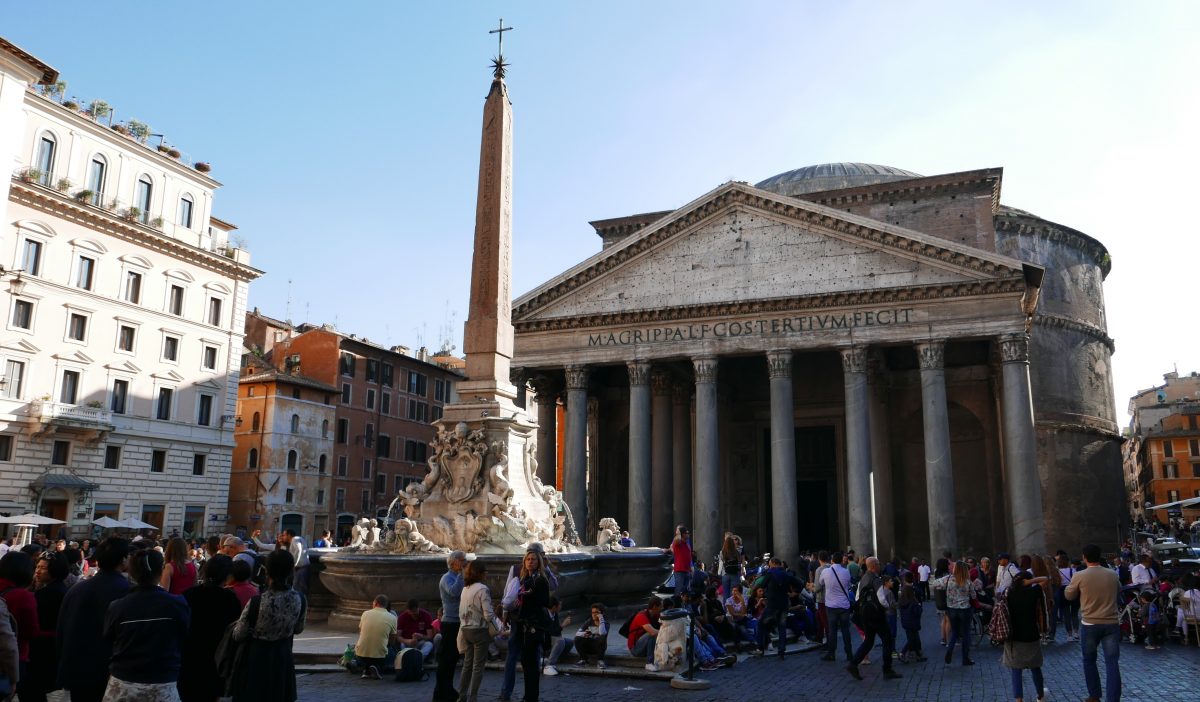
Things to see in Rome for a weekend
If I wanted to describe only the most popular things to see in Rome, I would need a few days to do it properly. Since I don’t have that much time, and neither do you, I gathered my favorites in the post “5 things to do in Rome” instead. The only thing which seems right to be said at this point is: Rome is glorious. You will see that the moment you step out of your hotel and on every step of your way. And luckily, the city of Rome is doing its best to preserve the architectural heritage of the ancient Roman civilization. This is also one of the main reasons the traffic is closed in the historical center for non-resident cars. Which is truly a bliss.
I do feel obliged to mention one issue which you have to count on, probably in all seasons: the crowds. I read about Roma pass and tickets which you can buy online to skip the long queues, but I didn’t imagine it would be THAT serious. Forget about the Colosseum and Vatican if you didn’t get the ticket upfront. Unless of course you don’t mind waiting a couple of hours under the Roman sun. Good luck there!
Taking everything into consideration the question is: “Can you do Rome in three days?” You can, if you Travel with Anda 😉 Honestly, we weren’t under any pressure, and we didn’t want to wait the long lines to enter the major attractions. We were quite happy with what Rome has to offer on foot and “from the outside”. You can walk around Colosseum to embrace its greatness, climb the stairs of beautiful Altare della Patria, throw a coin into Fontana di Trevi, listen to the street music in the romantic Piazza Navona, walk up the Gianicolo hill to see Rome from the top, visit Vatican and imagine the crowds during the masses in St Peter’s Square, take a stroll among lovely Villa Borghese gardens and make selfies on the Spanish steps, which have been renovated in 2016.
Italian coffee and food
Yep, you can do all that in three days with comfortable walking shoes. On top of that you have to taste Italian coffee, which is in my opinion the best in the world, and sit in any of the restaurants on your way to enjoy the food. Food with a capital F. I mean what is it with these Italians? Even a pizza or a simple pasta on every corner taste heavenly. We live in the neighbor country and I feel like we are worlds apart when it comes to cuisine!
Well, the grass is always greener on the other side. And since all roads lead to Rome, I am definitely coming back again. Ciao Roma, a presto!
You can check the rest of my photos in my Facebook album Rome, Italy.
Slovenes abroad: Sasa, Malmö (Sweden)
Curiosity, a desire for new challenges and business opportunities led Saša to the ‘’cold north’’ two years ago. She landed in Malmö, a town in the south of Sweden, but judging by her tweets, the temperature there does not fall behind the rest of the country. Honestly, since I REALLY hate cold, I have never even thought about visiting Sweden. But after this chat with Saša, there is a high chance I will drop her a visit very soon.
Hi, Sasha. Why Sweden?
It just happened. I was always drawn to Sweden in some way. It was in one of my school trips to Planica, when I bought a Swedish flag instead of Slovenian and shortly afterwards I started learning basic Swedish numbers out of plain curiosity. Apparently, Sweden was always meant to be 🙂
Was the decision to move hard?
Not really, because the idea of moving was building for a while. Compared to Slovenia, bigger countries offer the possibility to work on larger projects with greater challenges in certain disciplines and, of course a better pay. You do need a bit of “balls” to take the first leap and the first year is the hardest.
How was the decision to leave accepted by your close family?
Ever since I was little my parents have encouraged me to take part in international exchanges and we traveled a lot throughout my childhood. Because of that nobody was really that much surprised, although I can’t say it was easy for everyone or anyone.
Was language a problem? Can you already speak Swedish?
Undoubtedly, the language was initially an obstacle. Scandinavian languages in their written form vary a lot from their spoken version. After approximately one year of intensive learning I can say that I understand and engage in everyday conversations. Still, I find it a challenge if I run into someone with a distinct ‘Skånska’ accent. Copenhagen is 15 minutes away and consequently people in the south have a sharp accent, reminiscent of Danish. This is the language of “potatoes in the mouth”. 🙂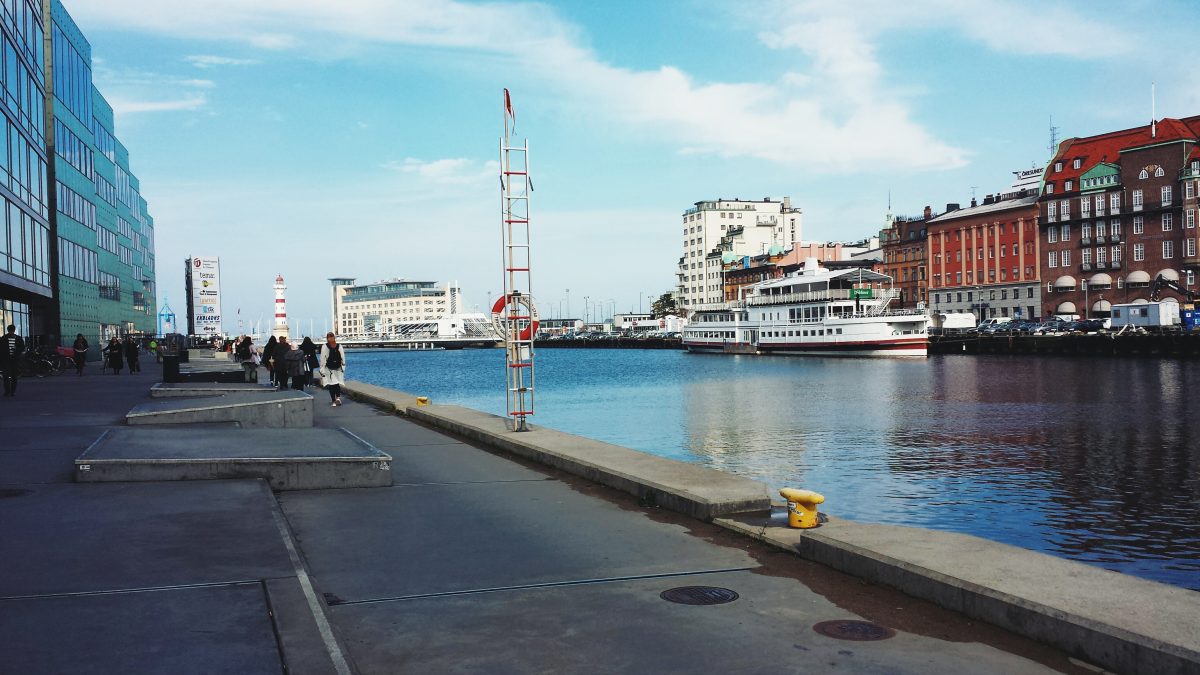
What was the biggest positive surprise for you after moving to Sweden?
The level of confidence you get from strangers. Many goods, particularly in living complexes are in common use. For example cast iron grills in the garden, common areas, workshop rooms where tools stay at their place. People here are aware that they are not alone in the world and not think only of themselves.
Did you have any negative experience being a foreigner?
Absolutely not. The Swedes are very open and the majority accepts diversity. Maybe my appearance helps my integration process (light skin, blue eyes) and the fact that I come from a developed country, with similar standards and habits. But I know a few people, mainly Muslim women, which feel a slight uncertainty when talking to a stranger. They say that some people are often skeptical of them.
Can you afford a decent lifestyle with an average Swedish salary?
Life with an average Swedish paycheck is more than decent. Disposable income is much greater than in lots of other countries. That, plus other work perks like default 25 vacation days and 480 days of maternity leave, make life here quite comfortable.
Since this is a “hot” topic in Slovenia now – how is Swedish healthcare system?
Organized but very bureaucratic. You pay for every first visit to the doctor – to ‘’open the case’’. That prevents people going to the doctor without having a real reason to go there. The price is fixed at 200 SEK (around 20€) for a general practitioner and 500 SEK for a specialist.
Dental care is a headache though. Not all dental care for people over 20 years is free and it can get REALLY expensive. That’s why Swedes take great care of their teeth and get all the problems fixed before the age of 20.
How often do you travel home?
Approximately twice a year. I love my proximity to Copenhagen Airport and direct flight connections to Ljubljana, which means that I get up in the morning and I am at my mom’s dinner table by lunchtime.
What has in your opinion changed in Slovenia since you moved out?
I am so pleased to note huge steps forward, primarily within Ljubljana. Many more workshops and meetings with the mentality “the community can only grow by sharing knowledge”, which reminds me a lot of the whole Swedish shabang. After a few years of living abroad you see your town in a different light. You catch yourself idealizing it, city colors are suddenly more vivid and people seem friendlier.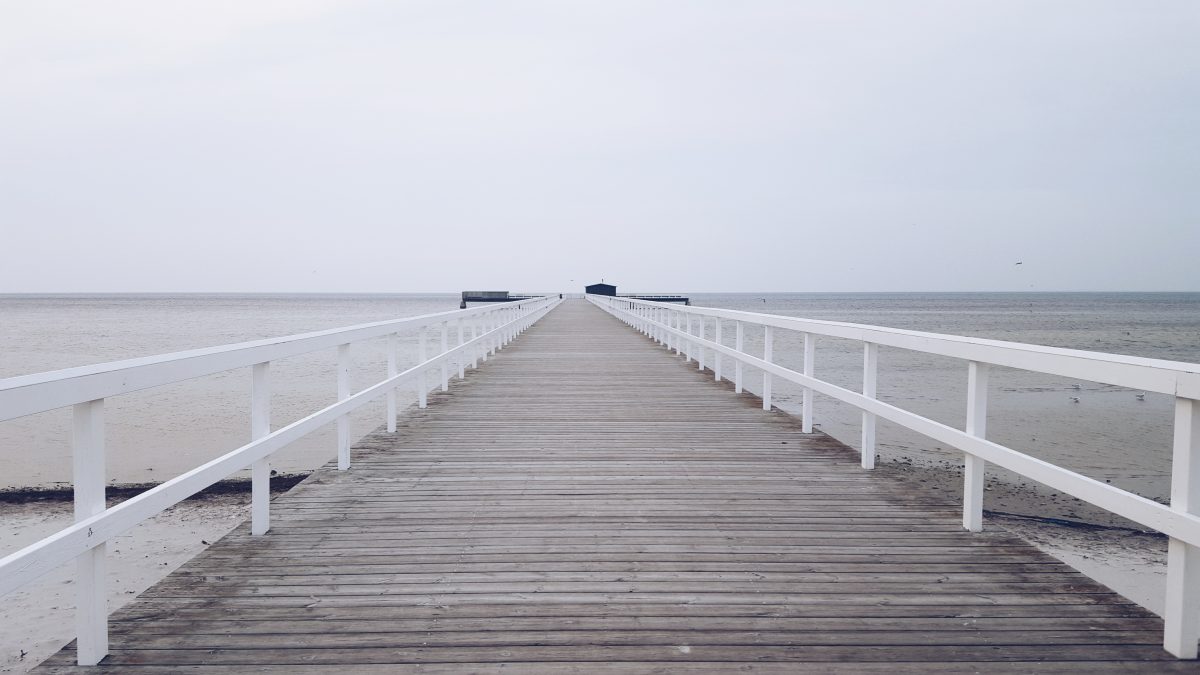
How do you spend your free time?
You can usually find me either in a pub or in the nature. Malmö has everything from vast forest spaces to botanical gardens and lakes. In the summer I spend a good part of my time on the beach. The sun beats down just the right amount, the sea is colder, less salty and the beaches offer so many activities to choose from.
You know I have to ask: Zlatan Ibrahimović?
I know where his villa stands and that’s about it. Zlatan is a textbook example of an immigrant’s success. On football match days the city turns into blue and white, the colors of the FC Malmö, and a plethora of people from all sides of the city go to the stadium. That’s when I usually go in the opposite direction.
5 things every tourist in Sweden should see?
First, everyone should experience Midsommar (celebration of the longest day in the year) in a cottage Swedes call ‘’stuga‘’. It is a kind of wooden summer house in the woodlands, where many people gather and celebrate long days and light in general. Ladies wear wreaths of flowers and everyone dances around a kind of pagan maypole. In the evening people really loosen up and it is probably no coincidence that a lot of Swedes are born in March 😉
Then there is the magic of the mining town of Kiruna, which lies approximately at the same latitude as central Greenland. Third is the town Lund with one of the best universities in the world (go and see their library!) and an interestingly built Lund Cathedral from 1080, when the south of Sweden was still under Denmark’s rule. Inside, you can find an astronomical clock from the 14th century.
Let’s not forget the old town centers: Gothenburg, Helsingborg and Stockholm. You could hardly be bored in any of them.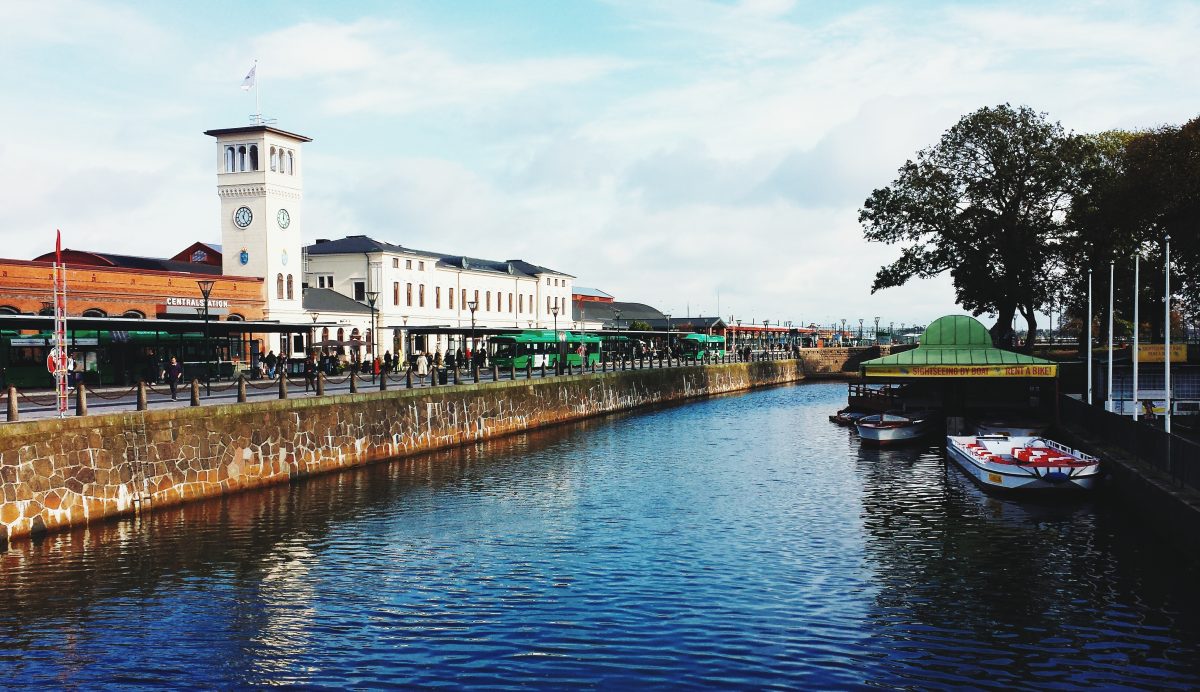
…and in Malmö?
Most people come into town across the Öresund Bridge, which is one of the major tourist attractions itself. Öresundsbron links Denmark to Sweden and extends partially above and below sea level. Turning Torso in Malmö is currently the tallest building in Scandinavia. City Library is an excellent architectural example of merging the new with the old. Lilla torg is the most likable market in the city and totally worth spending Friday evenings in restaurants with intense prices. Möllevångstorget is the market where so many cultures meet and mix. And of course my love – the beach.
Typical Swedish food is? Do you like it?
Swedes don’t really excel when it comes to gastronomy. Typical are small meatballs and potatoes – in millions of ways. I also like Sill, which is a pickled fish in different variations of spices and sauces. Another typical dish is ”Räksmörgås” – open-top sandwich with a huge amounts of shrimp, eggs, mayonnaise and lemon, all on rye bread. The Swedes have the utmost love for anything sweet. Bought bread is often sweetened, which I never really got used to.
What do you miss most, other than relatives and friends?
Mountains. Hills. My dogs. A longer spring and autumn. Slovene language. I miss not having to pay 10 euros for a glass of wine at dinner. I miss the Slovene spontaneity, especially when it comes to visiting a friend. Swedes usually have to have everything planned waaay in advance.
What do Slovenes usually ask you about Sweden?
”Is alcohol really as expensive as they say?” Yup, it is.
Are you ever coming back to Slovenia for good?
I don’t intend to, but it can happen. Currently Sweden offers everything I need and more.

Slovenci v svetu: Saša, Malmö (Švedska)
Radovednost, želja po novih izzivih in poslovna pot so Sašo pred dvema letoma pripeljali na “mrzli sever”. Pristala je v mestecu Malmö, ki sicer leži na jugu Švedske, a sodeč po njenih tvitih temperaturno ne zaostaja za preostalim delom države. Ker sem sama bolj pri “zmrznjenih”, o potovanju na Švedsko nisem še nikoli razmišljala. Saša pa me je z odgovori čisto navdušila in ni dvakrat za reči, da jo bom šla obiskat že naslednje poletje.
Živjo, Saša. Zakaj Švedska?
Kar nekako se je zgodilo. Zanimivo je, da sem na nekem šolskem izletu v Planico namesto slovenske kupila švedsko zastavo in se kmalu zatem, iz čistega firbca, naučila šteti po švedsko. Očitno mi je bila že od nekdaj namenjena 🙂
Je bila odločitev o selitvi težka?
Niti ne, saj se je ideja v nama kuhala že dalj časa. V primerjavi s Slovenijo ponuja tujina možnost dela na večjih projektih, z večjimi izzivi v določenih strokah in seveda posledično boljše plačilo. Za prvi korak je potrebno nekoliko poguma in prvo leto je najtežje.
Kako so jo sprejeli tvoji najbližji?
Doma so me že kot smrkljo spodbujali k mednarodnim izmenjavam in tekom celotnega otroštva smo veliko potovali. Zato selitev nikogar ni čisto zares presenetila, seveda pa ni bilo za vse enako lahko.
Je bil jezik ovira? Že govoriš tekoče švedsko?
Nedvomno je bil jezik na začetku ovira. Skandinavski jeziki se v svoji pisani obliki precej razlikujejo od govorjene. Po približno enem letu intenzivnega učenja lahko rečem, da razumem in sledim vsakdanjim pogovorom. Še vedno pa mi predstavlja oviro, če naletim na koga z izrazitim ‘’skånskim’’ naglasom. Kopenhagen je 15 minut stran in posledično imajo južni Švedi naglas, ki spominja na danščino. To je tista govorica “s krompirjem v ustih”. 🙂
Kaj te je na švedskem najbolj pozitivno presenetilo?
Zanimiva je stopnja zaupanja, ki jo neznanci drug drugemu izkazujejo. Veliko dobrin, predvsem v blokovskih kompleksih, je v skupni uporabi. Na primer litoželezni žari na vrtu, skupni prostori v smislu delavnice, v kateri se nahaja orodje, ki tam tudi ostane. Ljudje se zavedajo, da niso sami na svetu in le sami sebi namen.

Kakšna negativna izkušnja, ker si tujka, bodisi pri iskanju službe, ali v javnosti?
Nikakor ne. Švedi so zelo odprti in večina sprejema drugačnost. Mogoče pri moji integraciji pomaga moj videz in to, da prihajam iz razvite države. Poznam pa tudi nekaj ljudi, predvsem muslimanskih žensk, ki med pogovorom začutijo rahlo nesigurnost s strani sogovornika. Pravijo, da so nekateri ljudje do njih nemalokrat skeptični.
Se da dostojno živeti s povprečno švedsko plačo?
Več kot dostojno. Razpoložljivi dohodki so precej višji kot v ostalih državah. Če dodamo še ostale ugodnosti, kot na primer najmanj 25 dni dopusta in 480 dni porodniške, lahko rečem, da Švedska nudi zelo udobno življenje.
Kako pa je z zdravstvom? V Sloveniji je to trenutno zelo vroča tema…
Švedska ima dobro organiziran, ampak precej birokratski zdravstveni sistem. Za vsak prvi obisk splošnega zdravnika plačaš 200 SEK (okoli 20€), da “odpreš primer”. S tem preprečijo, da bi k zdravniku hodili kar tako, brez pravega razloga. Za specialista plačaš še več, 500 SEK (znesek se viša s stopnjo specializacije).
Je pa zobozdravstvo posebna »bolečina«. Po 20 letu namreč vse zobozdravstvene storitve niso brezplačne in če imaš težave z zobmi, je lahko vse skupaj RES drago. Zato Švedi večinoma zelo dobro skrbijo za ustno higieno in se zelo potrudijo, da si uredijo zobe pred 20. letom.
Kako pogosto se vračaš domov?
Domov se vračam nekje na pol leta, oziroma po potrebi. Paše mi bližina Kopenhagenskega letališča in direktna letalska povezava z Ljubljano, kar pomeni, da zjutraj vstanem in sem za kosilo že doma. Žal mi je le, da me edini slovenski letalski prevoznik vse prevečkrat prisili v razmišljanje o uporabi linije Kopenhagen – Zagreb, ki je precej cenejša in ponuja kvalitetnejše storitve.
Kaj se je po tvojem opažanju spremenilo v Sloveniji, odkar si se odselila?
Z velikim veseljem opažam korake naprej, predvsem znotraj Ljubljane. Veliko več je delavnic in srečanj z mentaliteto ‘’delimo znanje, ker le tako lahko kot skupnost rastemo’’, kar me zelo spominja na švedski duh. Zdi se mi, da se je Ljubljana nekoliko sprostila, opažam več odkrite ‘’drugačnosti’’, ljudje si upajo biti to, kar so. Ko nekaj let živiš zunaj domovine, jo vidiš v drugačni luči. Na trenutke jo celo idealiziraš, barve so kar naenkrat bolj žive in ljudje bolj prijazni.
Kako preživljaš prosti čas?
Najraje ga preživljam v pubu in v naravi. Malmö ima ogromno zelenih površin, od mikro gozdov pa do botaničnih vrtov in jezer. Poleti preživim dobršen del prostega časa na plaži. Sonce pripeka ravno prav, morje je hladnejše in manj slano, na plažah se odvija ogromno aktivnosti.
Saj veš, moram: Zlatan Ibrahimović. Že imaš njegov avtogram?
Tu te moram razočarati. Vem, kje stoji njegova vila in spoštujem simboliko, ki prežema njegovo osebnost. Zlatan je nekakšen šolski primer uspeha za vse, ki prihajajo iz tretjih držav. Včasih se mesto obarva v sinje modro in belo, barve nogometnega kluba Malmö, in množica ljudi se iz vseh strani mesta začne valiti proti stadionu. Takrat grem pač v nasprotno smer.
Naštej 5 stvari, ki jih mora po tvojem mnenju na švedskem videti vsak turist.
Nujno moraš doživeti Midsommar (najdaljši dan in največji praznik) in to v koči, ki ji Švedi rečejo ‘’svensk stuga’’. Gre za nekakšne lesene vikendice, kjer se zbere ogromno ljudi in skupaj proslavljajo dolge dneve. Dame nosijo vence iz cvetlic in vsi plešejo okoli nekakšnega poganskega mlaja. Na Midsommar večer se vsi sprostijo in verjetno ni naključje, da je veliko Švedov rojenih v mesecu marcu 😉
Potem je tu čarobno rudarsko mestece Kiruna, ki leži nekje na geografski širini kot centralna Grenlandija. Blizu Malma se nahaja študentsko mesto Lund, z eno najboljših univerz na svetu. Univerzitetna knjižnica mi je dala občutek, da sem v kakšnem od Harry Potter filmov. V Lundu je zanimiva tudi katedrala iz leta 1080, ko je bila južna švedska še pod Dansko. Znotraj nje se nahaja še astronomska ura iz 14. stoletja.
In pa seveda sama stara mestna jedra: Gothenburg, Helsingborg in Stockholm. Težko ti je dolgčas v kateremkoli od njih.
Pa v Malmu?
Najpogosteje prideš v mesto po mostu, ki je že sam po sebi ena večjih turistični atrakcij. Most Öresundsbron namreč povezuje Dansko in Švedsko ter se razteza delno pod in nad gladino morja. Turning Torso v Malmu je trenutno najvišja stavba v Skandinaviji. Mestna knjižnica je odličen prikaz združevanja novega in starega gradbenega stila. Lilla torg je najbolj prikupen trg na tem svetu in povsem vreden petkovih večerov v restavracijah z navitimi cenami. Möllevångstorget je trg, kjer se srečajo in zmešajo praktično vse kulture, kar jih mesto premore. In pa seveda plaža, ki jo obožujem.
Tipična švedska hrana je? Ti je všeč?
Švedi se ne morejo ravno pohvaliti z gastronomskimi presežki. Nekaj tipičnega so mesne kroglice (kot čufte, samo manjše, brez omake) in krompir. Krompir na miljone načinov. Drugo pravilo švedske kuhinje je, da brusnice pašejo z vsem. Osebno so mi všeč vloženi koščki rib, v raznih variacijah začimb in omak. Še ena tipična zadeva je ‘’Räksmörgås’’, sendvič odprtega tipa, z ogromno količino rakcev, jajc, majoneze in limone na rženem kruhu. Švedi imajo nadvse radi tudi sladko. Njihov kupljeni kruh je nemalokrat sladkan, česar se nikoli nisem navadila, zato ga niti ne kupujem.
Kaj najbolj pogrešaš, razen sorodnikov in prijateljev?
Gore. Hribe. Svoje pse. Daljše pomladi in jeseni. Materni jezik. Pogrešam ne plačati 10 € za kozarec vina ob večerjah. Posedanje v lokalčkih ‘’na kavi’’ – tega koncepta tu skoraj ni. Pogrešam tudi slovensko spontanost, sploh kar se tiče obiskovanja.
Kaj te Švedi najpogosteje vprašajo o Sloveniji?
“Zakaj so Slovenci zavrnili referendum o istospolnih porokah? Sem mislil, da je Slovenija napredna in sprejemajoča država…’’ … ob spremljavi pogleda, ki ti ga ponavadi da mama, ko jo globoko razočaraš.
Kaj pa Slovenci o Švedski?
‘’Ti, a je alkohol res tok drag tm gor?’’ Ja, je.
Se nameravaš kdaj vrniti?
Nameravam ne, lahko pa se zgodi. Trenutno mi Švedska nudi vse, kar potrebujem, in še več.


